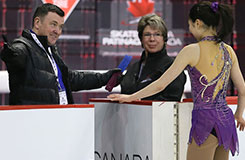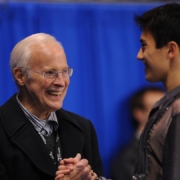Canadian coach Brian Orser creating champions in Toronto
There was a time, years ago, when Brian Orser carried a flag into an Olympic Games opening ceremonies, all red and white and befringed.
Proud moment of his life, that day at the Calgary Olympics. The days that followed were more difficult. He had expected to win gold. He won silver.
He’s carrying flags still, but in another role that he never anticipated: coach. And now he’s coach of two Olympic champions in back-to-back Games. He’s now guiding others to do what he did not. Orser, the most entertaining coach at the boards, has now become a hot commodity, a Canadian maestro of edges and packaging, and strategies.
Being a coach wasn`t part of Orser’s big plan when he competed, and then when he skated on tours for 17 years. When asked, Orser would always say he did not see himself coaching. He didn`t know if he had the patience for it.
Skating is one thing. Teaching is another. But during the odd seminar with young skaters, Orser began to get great feedback about his style of teaching, his ability to relate to the kids. He got the teaching bug and he started to understand how to teach it.
When first presented with the opportunity of becoming director of skating at the Toronto Cricket, Skating and Curling Club in Toronto, Orser’s first reaction was: “No.” He was living in Ottawa at the time, and he wasn`t sure if he had the tools to run a program.
The clincher was a call from long-time friend, Tracy Wilson, who asked him if she did it with him, would he consider it? Orser said: “Sure.”
“If I’m going into uncharted waters, I need to have somebody with me, in everything in life,” he said. He’s surrounded by a talented team: Wilson and world renowned choreographer David Wilson and now also 2008 world champion Jeffrey Buttle, and who brings a different energy into the mix, because he’s still out in the world, skating.
One of Orser’s first students was Yuna Kim, a skater with loads of jumping talent, who originally came to the Cricket Club to work with David Wilson. While there, she asked Orser to look at her work and she stayed.
While it’s great luck to land such a talented world skater, it’s almost more of a challenge to coach one, Orser said. “If you mess that up, then you`re not a very good coach,” he said.
His job was to shore up Kim`s weaknesses and take her skating to another level. She wasn`t the happiest skater when she arrived, Orser said. “I don’t think she was happy in her life,” he said. “I don’t think she really knew what she was, other than an athlete.” She had no identity outside of skating. Orser and his team decided their mandate was to find some happiness for her through skating. “Bit by bit, we started peeling off the layers of the onion.”
It worked. And Orser proved he was no one-hit wonder, by transforming Christina Gao from an okay junior skater to a top-notch skater, who found her passion. When Gao was accepted into Harvard University, Orser was like “a proud papa,” he said. He also worked with two-time world junior champion Adam Rippon.
Now, Orser is proud of his latest accomplishments: turning Yuzuru Hanyu from a kid with wild passion into an Olympic champion at age 19, and guiding Javier Fernandez to become a two-time European champion – because he believed in the Spanish skater.
Orser remembers seeing something special about Hanyu in the years before he taught him, although “it was just a little out of control,” he said. Orser never saw the same choreography from him twice. “He would just kind of wing it,” Orser said. “He was more of an emotional skater.”
Hanyu bought into what Orser and his team offered: breaking down the skating to the basics, building a foundation that fosters trust. “It’s all about balance and power and just effortless skating,” Orser said.
Orser treads a fine line with Hanyu: the passion is more controlled, but Orser doesn’t want Hanyu to lose it, either. Being Olympic champion has not gone to Hanyu’s head, Orser said. He’s been showing off his medal in the change room, but then he’s willing to go back to the ice to work on a crossover and work on basics for an hour. “We’re paying attention to every single little transition,” Orser said.
Transitions? They are not just part of the program component mark. They are what skating is all about, Orser says. Skaters can use the transitions to gain speed, to get down the ice or around a corner, rather than having to push.
For a couple of years now, Orser has had to switch team jackets between Spain and Japan, and at the Sochi Olympics, it reached a fever pitch when both skaters competed in the same group. But at the world championships in Japan this month, Orser will wear a third: Canada (finally!). It’s like coming home, almost. He’ll be guiding 15-year-old Nam Nguyen, who has been skating in the same rink as Fernandez and Hanyu, and looking up to them. Now he’ll be sitting at the same draws.
Orser and his crew must be doing something right. And people are recognizing it. Every week, Orser will get two or three messages in his email inbox from a skating parent sending him a YouTube video, saying: “Here`s my daughter. Have a look.” They come from everywhere. Even from Russia.
Beverley Smith





Leave a Reply
Want to join the discussion?Feel free to contribute!